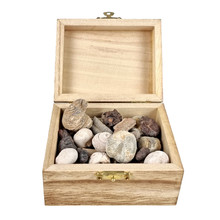Ammonites were a group of marine mollusks where the current squid also belongs to. they are extinct and found as fossils. Read more.
Wooden treasure box with various fossils from Morocco, Brachiopods (shells), Gastropods (snail shells), black ammonite fragments, sea urchin, Orthoceras and Crinoid.
Magnificent Perisphinctes Ammonite from Madagascar - A Unique Piece of History from the Late Jurassic Age some 163 to 145 million years old
Magnificent Perisphinctes Ammonite from Madagascar - A Unique Piece of History from the Late Jurassic Age some 163 to 145 million years old
Ammonites were a group of marine mollusks where the current squid also belongs to. Now days squids have their shell inside but the Ammonites had their shell outside their body, just like snails.
Origin of the ammonites
The first Ammonites appeared about 410 million years ago and became very successful. They appeared in oceans worldwide in large numbers. Like the dinosaurs, ammonites got extinct about 65 million years ago.
The house of an Ammonite
The Ammonites house consists of rooms. Whenever the hard case was too small for the animal it built a new room that was larger than the previous one. The animal always lived in the last build room. The empty rooms could be filled with water or gas. Like that the ammonite could travel between the surface and the bottom of the sea.
Origin of the Name
The ammonites name is derived from the ancient Egypt god ‘Amon’. Amon was often portrayed with rams horns. The fossils apparently looked a lot like those horns giving them the name "Ammonite".
Hildoceras ammonite
Hildoceras ammonites lived about 180 million years ago in the Lower Jurassic. They are found in Somerset in the Junction Bed, Falciferum zone in England.
Pyritized ammonites
Pyritized ammonites are found in Germany in the town of Buttenheim near Bamberg. The beautiful golden shine of these ammonites is immediately noticeable. This colour is caused by the iron ore pyrite. During the fossilisation of the ammonite, it did not petrify but was 'pyritised'. These ammonites belong to the Pleuroceras Spinatum family, which lived between 190 and 183 million years ago. This species mainly lived in the area where Europe is now located. Also in England beautiful pyrite ammonites are found.
Ammonite as a piece of jewelry
Ammonites also lend themselves well as beautiful jewellery. Cut ammonites from Madagascar where all the individual chambers are nicely visible, the polished ammonites from Morocco or the beautiful German pyrite ammonites. Each pendant is unique and tells its own story of these prehistoric creatures.
Cleoniceras ammonite
The Cleoniceras ammonites from Madagascar are one of the most beautiful. The exterior has a layer of opal with beautiful shades of colour and often the stitches are also visible. Cut through, this ammonite shows in a spectacular way the different chambers that are filled with calcite. In some cases even a small geode has been created in it. This ammonite species lived in albien and about 110 million years old.
Douvilleiceras ammonite
These special ammonites from Madagascar have the nice nickname: 'tractor ammonites'. The thick ribs on the ammonite are reminiscent of tractor tyres. These ammonites lived around the same time as the Cleoniceras ammonites in the under cretaceous and are about 112 million years old. These ammonites are completely fossilized in calcite and polished to show the beautiful colors, ripples and sutures.



